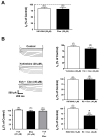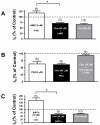Alpha-2 noradrenergic receptor activation inhibits the hyperpolarization-activated cation current (Ih) in neurons of the ventral tegmental area
- PMID: 20122999
- PMCID: PMC2854519
- DOI: 10.1016/j.neuroscience.2010.01.052
Alpha-2 noradrenergic receptor activation inhibits the hyperpolarization-activated cation current (Ih) in neurons of the ventral tegmental area
Abstract
The ventral tegmental area (VTA) is the source of dopaminergic projections innervating cortical structures and ventral forebrain. Dysfunction of this mesocorticolimbic system is critically involved in psychiatric disorders such as addiction and schizophrenia. Changes in VTA dopamine (DA) neuronal activity can alter neurotransmitter release at target regions which modify information processing in the reward circuit. Here we studied the effect of alpha-2 noradrenergic receptor activation on the hyperpolarization-activated cation current (I(h)) in DA neurons of the rat VTA. Brain slice preparations using whole-cell current and voltage-clamp techniques were employed. Clonidine and UK14304 (alpha-2 receptor selective agonists) were found to decrease I(h) amplitude and to slow its rate of activation indicating a negative shift in the current's voltage dependence. Two non-subtype-selective alpha-2 receptor antagonists, yohimbine and RS79948, prevented the effects of alpha-2 receptor activation. RX821002, a noradrenergic antagonist specific for alpha-2A and alpha-2D did not prevent I(h) inhibition. This result suggests that clonidine might be acting via an alpha-2C subtype since this receptor is the most abundant variant in the VTA. Analysis of a second messenger system associated with the alpha-2 receptor revealed that I(h) inhibition is independent of cyclic AMP (cAMP) and resulted from the activation of protein kinase C. It is suggested that the alpha-2 mediated hyperpolarizing shift in I(h) voltage dependence can facilitate the transition from pacemaker firing to afferent-driven burst activity. This transition may play a key role on the changes in synaptic plasticity that occurs in the mesocorticolimbic system under pathological conditions.
(c) 2010 IBRO. Published by Elsevier Ltd. All rights reserved.
Figures




Similar articles
-
Noradrenergic modulation of the hyperpolarization-activated cation current (Ih) in dopamine neurons of the ventral tegmental area.Neuroscience. 2007 Oct 26;149(2):303-14. doi: 10.1016/j.neuroscience.2007.08.009. Epub 2007 Aug 9. Neuroscience. 2007. PMID: 17884297 Free PMC article.
-
Serotonin reduces the hyperpolarization-activated current (Ih) in ventral tegmental area dopamine neurons: involvement of 5-HT2 receptors and protein kinase C.J Neurophysiol. 2003 Nov;90(5):3201-12. doi: 10.1152/jn.00281.2003. Epub 2003 Jul 30. J Neurophysiol. 2003. PMID: 12890794
-
Cocaine sensitization inhibits the hyperpolarization-activated cation current Ih and reduces cell size in dopamine neurons of the ventral tegmental area.J Neurophysiol. 2012 Apr;107(8):2271-82. doi: 10.1152/jn.00818.2011. Epub 2012 Jan 18. J Neurophysiol. 2012. PMID: 22262829 Free PMC article.
-
Neurophysiology of HCN channels: from cellular functions to multiple regulations.Prog Neurobiol. 2014 Jan;112:1-23. doi: 10.1016/j.pneurobio.2013.10.001. Epub 2013 Oct 29. Prog Neurobiol. 2014. PMID: 24184323 Review.
-
Regulation of firing frequency in nociceptive neurons by pro-inflammatory mediators.Exp Brain Res. 2009 Jun;196(1):45-52. doi: 10.1007/s00221-009-1744-2. Epub 2009 Apr 7. Exp Brain Res. 2009. PMID: 19350231 Review.
Cited by
-
Adrenoreceptor modulation of oromotor pathways in the rat medulla.J Neurophysiol. 2014 Aug 1;112(3):580-93. doi: 10.1152/jn.00091.2014. Epub 2014 May 7. J Neurophysiol. 2014. PMID: 24805080 Free PMC article.
-
The h-current in periglomerular dopaminergic neurons of the mouse olfactory bulb.PLoS One. 2013;8(2):e56571. doi: 10.1371/journal.pone.0056571. Epub 2013 Feb 13. PLoS One. 2013. PMID: 23418585 Free PMC article.
-
Perioperative Blood Pressure Management Recommendations in Pediatric Pheochromocytoma: A 10-Year Narrative Review.Kidney Blood Press Res. 2025;50(1):61-82. doi: 10.1159/000542897. Epub 2024 Dec 3. Kidney Blood Press Res. 2025. PMID: 39626645 Free PMC article. Review.
-
Cocaine sensitization increases I h current channel subunit 2 (HCN₂) protein expression in structures of the mesocorticolimbic system.J Mol Neurosci. 2013 May;50(1):234-45. doi: 10.1007/s12031-012-9920-4. Epub 2012 Dec 1. J Mol Neurosci. 2013. PMID: 23203153 Free PMC article.
-
Rapid regulation of depression-related behaviours by control of midbrain dopamine neurons.Nature. 2013 Jan 24;493(7433):532-6. doi: 10.1038/nature11713. Epub 2012 Dec 12. Nature. 2013. PMID: 23235832 Free PMC article.
References
-
- Aghajanian G, Bunney BC. In: Usdin E, Snyder SH, editors. Central dopaminergic neurons: Neurophysiologic identification and responses to drugs; Frontiers in catecholamine research; proceedings; Elmsford, N.Y., Pergamon Press. 1973.pp. 643–648.
-
- Berger T, Senn W, Luscher RL. Hyperpolarization-activated current Ih disconnects somatic and dendritic spike initiation zones in layer V pyramidal neurons. J. Neurophysiol. 2003;90:2428–2437. - PubMed
Publication types
MeSH terms
Substances
Grants and funding
LinkOut - more resources
Full Text Sources

